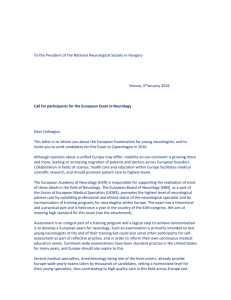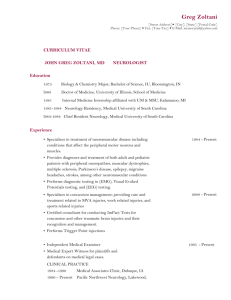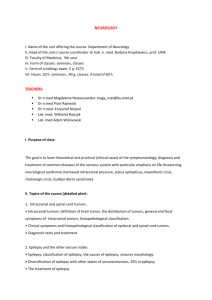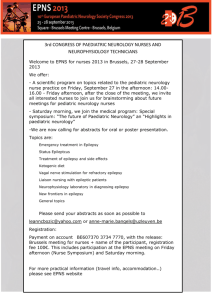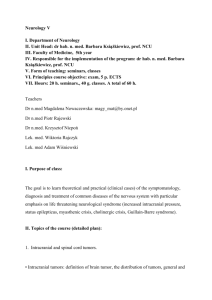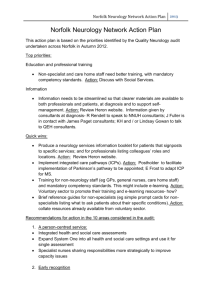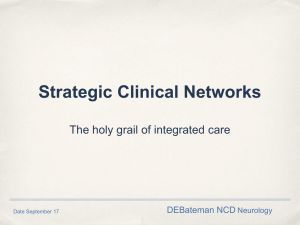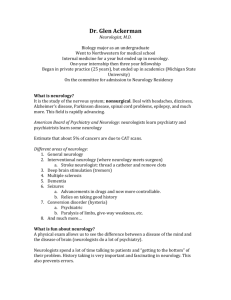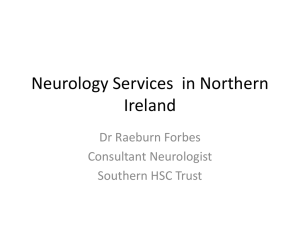Fahmida Chowdhury - Association of British Neurologists
advertisement
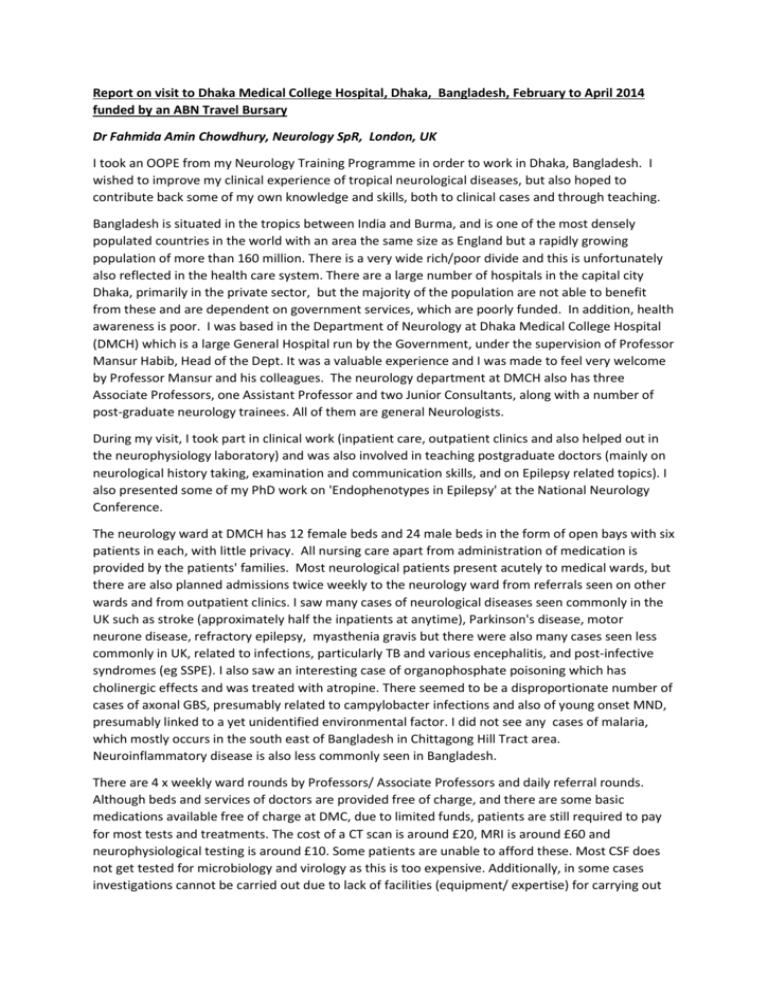
Report on visit to Dhaka Medical College Hospital, Dhaka, Bangladesh, February to April 2014 funded by an ABN Travel Bursary Dr Fahmida Amin Chowdhury, Neurology SpR, London, UK I took an OOPE from my Neurology Training Programme in order to work in Dhaka, Bangladesh. I wished to improve my clinical experience of tropical neurological diseases, but also hoped to contribute back some of my own knowledge and skills, both to clinical cases and through teaching. Bangladesh is situated in the tropics between India and Burma, and is one of the most densely populated countries in the world with an area the same size as England but a rapidly growing population of more than 160 million. There is a very wide rich/poor divide and this is unfortunately also reflected in the health care system. There are a large number of hospitals in the capital city Dhaka, primarily in the private sector, but the majority of the population are not able to benefit from these and are dependent on government services, which are poorly funded. In addition, health awareness is poor. I was based in the Department of Neurology at Dhaka Medical College Hospital (DMCH) which is a large General Hospital run by the Government, under the supervision of Professor Mansur Habib, Head of the Dept. It was a valuable experience and I was made to feel very welcome by Professor Mansur and his colleagues. The neurology department at DMCH also has three Associate Professors, one Assistant Professor and two Junior Consultants, along with a number of post-graduate neurology trainees. All of them are general Neurologists. During my visit, I took part in clinical work (inpatient care, outpatient clinics and also helped out in the neurophysiology laboratory) and was also involved in teaching postgraduate doctors (mainly on neurological history taking, examination and communication skills, and on Epilepsy related topics). I also presented some of my PhD work on 'Endophenotypes in Epilepsy' at the National Neurology Conference. The neurology ward at DMCH has 12 female beds and 24 male beds in the form of open bays with six patients in each, with little privacy. All nursing care apart from administration of medication is provided by the patients' families. Most neurological patients present acutely to medical wards, but there are also planned admissions twice weekly to the neurology ward from referrals seen on other wards and from outpatient clinics. I saw many cases of neurological diseases seen commonly in the UK such as stroke (approximately half the inpatients at anytime), Parkinson's disease, motor neurone disease, refractory epilepsy, myasthenia gravis but there were also many cases seen less commonly in UK, related to infections, particularly TB and various encephalitis, and post-infective syndromes (eg SSPE). I also saw an interesting case of organophosphate poisoning which has cholinergic effects and was treated with atropine. There seemed to be a disproportionate number of cases of axonal GBS, presumably related to campylobacter infections and also of young onset MND, presumably linked to a yet unidentified environmental factor. I did not see any cases of malaria, which mostly occurs in the south east of Bangladesh in Chittagong Hill Tract area. Neuroinflammatory disease is also less commonly seen in Bangladesh. There are 4 x weekly ward rounds by Professors/ Associate Professors and daily referral rounds. Although beds and services of doctors are provided free of charge, and there are some basic medications available free of charge at DMC, due to limited funds, patients are still required to pay for most tests and treatments. The cost of a CT scan is around £20, MRI is around £60 and neurophysiological testing is around £10. Some patients are unable to afford these. Most CSF does not get tested for microbiology and virology as this is too expensive. Additionally, in some cases investigations cannot be carried out due to lack of facilities (equipment/ expertise) for carrying out those tests in Bangladesh (for example genetic testing/ specific antibody testing/ complex muscle biopsy tests). As a result doctors treatment tends to be empirical, based on the most likely diagnosis, and doctors have to rely on using clinical skills of history and examination, and need to be less dependant on complex/ expensive investigations to make a diagnosis. There are no neuroradiologists at DMC and scans may be misreported so neurologists tend to review their own scans. In terms of availability of common neurological drugs (within the government sector), basic drugs such as phenobaribitone, anti-TB drugs, paracetamol and some antibiotics are provided free of charge (while stocks last!) but patients are required to buy all other medications. Steroids are readily available and generally affordable, IVIg is available but generally unaffordable, and there were no facilities for plasma exchange. L-dopa is available and affordable, whereas dopamine agonists are available but usually not affordable. Thrombolysis has just become available for the first time in Bangladesh in one of the private hospitals. Each week, the department has three speciality clinics for Epilepsy, Stroke and Headache along with two more 'general' Outdoor Clinics. An admission card to a clinic costs 10Tk (about 10p) but again patients have to pay for all their tests and most drugs. Clinics take place in large rooms with multiple doctors and patients in a single room which restricts examination and patient confidentiality. Huge numbers of patients were seen in each clinic (eg in the outdoor clinics I was involved with there were around 100 patients, mainly new patients, with 4 doctors running the clinic). Amitriptylline was the most common drug used for migraine and almost all patients with epilepsy were taking phenobarbitone, phenytoin, carbamazepine and sodium valproate, due to other newer anti-epileptic drugs being unaffordable. Of note, there seemed to be a high proportion of patients with nonepileptic attacks (diagnoses based on history only since there are no Videotelemetry facilities). I was impressed with the formal postgraduate teaching programme within the department with 3x weekly lectures, which over a period of months covers a wide range of neurological topics and is delivered mainly by Professorial level staff. There is also substantial case based teaching during Consultant Ward Rounds. I believe this was a worthwhile experience for me and am grateful to the Association of British Neurologists for their support through my travel grant. Firstly the range of cases was immense. Some of these were neurological conditions common in the UK for which I hope my clinical contribution was helpful; others were more unusual 'tropical' cases which were a useful learning experience for me. My hosts were extremely welcoming and I learnt from them how to treat patients in a situation where resources are very limited, specifically, how to rely on clinical acumen rather than expensive/specialised tests. This visit was a good taster for me and I plan to return in future, to offer specialist knowledge and contribute to the teaching programme.

